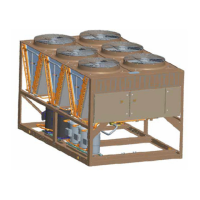JOHNSON CONTROLS
33
SECTION 4 – INSTALLATION
FORM 150.73-NM1
ISSUE DATE: 09/04/2020
4
Copper power wiring only should be used for supply-
ing power to the unit. This is recommended to avoid
safety and reliability issues resulting from connection
failure at the power connections to the unit. Aluminum
wiring is not recommended due to thermal character-
istics that may cause loose terminations resulting from
the contraction and expansion of the wiring. Alumi-
num oxide may also build up at the termination causing
hot spots and eventual failure. If aluminum wiring is
used to supply power to the unit, AL-CU compression
fittings should be used to transition from aluminum to
copper. This transition should be done in an external
box separate to the power panel. Copper conductors
can then be run from the box to the unit.
A 120-1-60, 15 A source must be supplied for the con-
trol panel through a fused disconnect when a control
panel transformer (optional) is not provided. See Fig-
ure 8 on page 40.
See unit wiring diagrams for eld and
power wiring connections, chilled water
pump starter contacts, alarm contacts,
compressor run status contacts, PWM
input, and load limit input. See SECTION
8 – UNIT OPERATION for a detailed de-
scription of operation concerning afore-
mentioned contacts and inputs.
COMPRESSOR HEATERS
Compressor heaters are standard. ZP103, ZP120 and
ZP137 compressors use 90 W heaters; ZP180 compres-
sors use 70 W heaters; ZP235 compressors use 120 W
heaters. If power is OFF more than two hours, the
crankcase heaters must be energized for 18 hours to 24
hours before restarting a compressor. This ensures that
liquid slugging and oil dilution does not damage the
compressors on start.
RELIEF VALVES
Relief valves are located on both the high and low
pressure side of the piping. High side relief valve pres-
sure setting is 650 psig. Low side relief valve pressure
setting is 450 psig.
HIGH PRESSURE CUTOUT
A high pressure cutout is installed in the discharge pip-
ing of each system. The cutout opens at 585 ± 10 psig
and closes at 440 ± 25 psig.
ELECTRICAL WIRING
Field Wiring
Power wiring must be provided through a fused dis-
connect switch to the unit terminals (or optional mold-
ed disconnect switch) in accordance with N.E.C. or
local code requirements. Minimum circuit ampacity
and maximum dual element fuse size are given in the
Electrical Data on page 45.
A 120-1-60, 15 A source must be supplied for the con-
trol panel through a fused disconnect when a control
panel transformer (optional) is not provided. See Fig-
ure 4 on page 22 and Figure 10 on page 41.
See Figure 3 on page 21 and Figure 10 on page 41
and unit wiring diagrams for field and power wiring
connections. See SECTION 8 – UNIT OPERATION
for a detailed description of operation concerning unit
contacts and inputs.
Liquid Line Solenoid Connections
The field supplied and installed liquid line solenoid
valves should be installed at the evaporator and wired
using 18 AWG minimum wire. Electrical connections
should be made at 1-XTBF for Sys. #1 and 2-XTBF for
Sys. #2. Note that power for the solenoid coil is 120
VA C . See Figure 11 on page 60, Figure 12 on page
70, and unit wiring diagram.
Discharge Air Sensor
The discharge air sensor and associated connector
hardware is factory supplied but must be field installed.
Field wire must be field supplied (QUABBIN 930421-
2 or equivalent 2 conductor with shield and drain wire
- 20 AWG 300 V 60°C - polyethylene insulation UV
resistant). Field wiring is connected to pins 3, 6, and
9 of J6 on the microboard. See Figure 9 on page 40
and unit wiring diagram.
Zone Thermostats (Remote Start/Stop)
Field supplied thermostats or dry contacts must be
field wired when operating the unit in Suction Pres-
sure Control Mode. The System 1 zone thermostat is
field wired at XTBC1 terminals 13 to 51. On two sys-
tem units, System 2 zone thermostat is field wired to
XTBC1 terminals 13 to 50. XTBC 1 terminal is located
near the bottom of the micro control panel. See Figure
3 on page 21 and unit wiring diagram.

